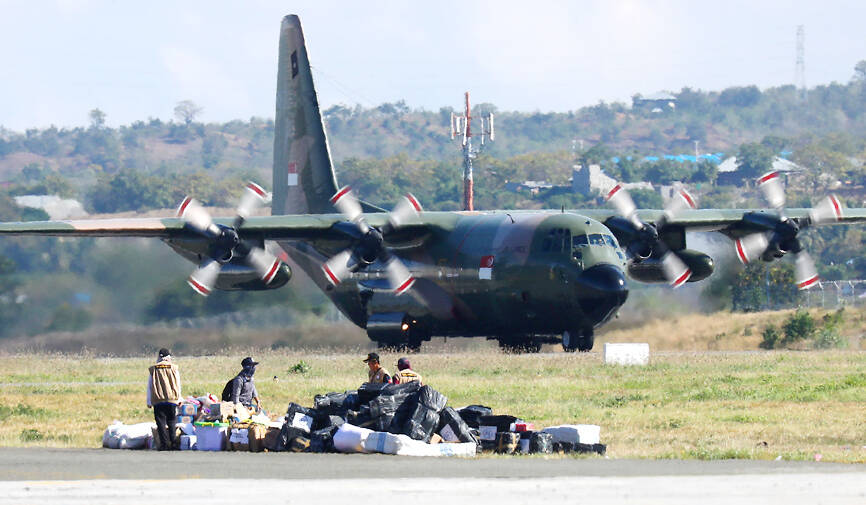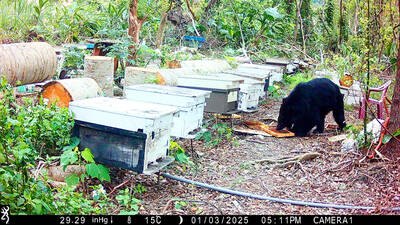The exercise presented a fraught scenario: China’s military had blockaded Taiwan by air and sea, and Southeast Asian countries were grappling with how to evacuate as many as 1 million of their nationals trapped on the besieged nation.
Over two days in April at a Singapore hotel, about 40 participants and observers in the war game, including serving and retired Asia-Pacific region officials and military officers, as well as security academics, simulated their responses to the unfolding crisis, four people familiar with the discussions said.
Hours ticked by as some players weighed unified action through ASEAN, while others reached out to the mock US, Chinese and Japanese delegates to negotiate special air and sea corridors to extract foreign nationals. Eventually, the people said, a stark conclusion emerged: The Southeast Asian states needed a Singaporean airlift to have a chance of evacuating their people.

Photo: REUTERS
“Nothing was moving until the Singaporeans stepped in at the 11th hour,” said one participant in the event at the Jen Singapore Tanglin hotel. “They had found a way of getting their own people out, and offered to get others out, too.”
Reflecting its discreet and decades-old security presence inside Taiwan, where its forces train, Singapore was able to leverage access to airfields and aircraft, the person said.
However, the exercise ended before any detailed discussion of how Singapore had reached a deal with China to secure an evacuation route through the blockade, or how precisely it would work, three of the people said.
CONTINGENCY PLANS
The previously unreported exercise comes amid an escalating battle between the US and China for dominance in the Asia-Pacific region. It offers a rare window into contingency planning over Taiwan, which some Asian and Western military attaches and security analysts say is becoming increasingly necessary because an assault on Taiwan by Beijing could draw in the US and imperil other countries.
While the scenario did not reflect official policies, participants playing the roles of foreign and defense ministers worked from the known positions of at least nine governments depicted in the simulation, said the four people, who like some others spoke on the condition of anonymity to discuss a sensitive matter. Besides Singapore, China, Taiwan and the US, the rest included Indonesia, Vietnam and the Philippines, they said.
Southeast Asians account for about 94 about of the almost 1 million foreign nationals resident in Taiwan, according to Taiwan’s National Immigration Agency. Indonesians, Vietnamese and Filipinos make up the vast majority of those foreigners, with comparatively small numbers of Japanese and Americans.
The Singaporean Ministry of Defense said it was not involved in the “workshop” and none of its officials attended in any capacity. Neither the defense nor foreign ministries addressed questions about Singapore’s military presence in Taiwan and planning for Taiwan conflict scenarios, including evacuations.
The Chinese Ministry of Foreign Affairs said it had “always resolutely opposed countries with whom it has diplomatic relations having any form of official relations with the Taiwan region, including military dialogue and cooperation,” adding that it was not aware of the circumstances of the exercise.
The London-based International Institute for Strategic Studies (IISS), which organized the exercise, said in a statement that participants had attended in their private capacities, and that it could not comment on “discussions, attendees or any other elements.”
The Ministry of Foreign Affairs in Taipei and the ASEAN Secretariat in Jakarta did not respond to questions.
A Pentagon official said they were not aware of any official participation in the event by the US Department of Defense.
“We routinely engage with allies and partners to ensure readiness for a range of contingencies, but it would be inappropriate to discuss operational planning or hypothetical evacuation scenarios,” the official said.
Weeks after the exercise, US Secretary of Defense Pete Hegseth told a security conference in Singapore that the threat of China using force to take Taiwan was “imminent” amid intensifying air and naval operations around the island by the Chinese People’s Liberation Army.
Chinese officials have said Hegseth and other Trump administration officials are playing up “the so-called China threat,” with the Chinese embassy in Singapore saying his speech was “steeped in provocations and instigation.”
MEANINGFUL TIES
Drew Thompson, a Senior Fellow at the S. Rajaratnam School of International Studies at Nanyang Technological University in Singapore, said it was vital for Southeast Asian countries to move beyond war games and contingency discussions to build meaningful, unofficial ties with Taiwan, particularly its military. These countries have diplomatic ties with Beijing and do not officially recognize Taipei.
“The big takeaway here is that a plan is one thing, but you need the access and the relationships to put it into play,” said Thompson, who was not involved in the exercise.
“Singapore has long had these ties, the Philippines is building them, but it remains an open question whether the other countries in Southeast Asia have the unofficial networks in place to meaningfully engage with Taiwan in a conflict.”
The Philippines Ministry of Foreign Affairs said that the government has contingency plans for a Taiwan emergency, without offering specifics. It added that Manila has “legitimate interest in Taiwan due to geographic proximity and the presence of Filipino nationals there.”
The foreign ministries of Indonesia and Vietnam did not respond to requests for comment. The Japanese Ministry of Defense declined to comment.
Given recent drills in which Chinese vessels encircled Taiwan, some military attaches and analysts say any attempt by Beijing to seize the Taiwan could start with a blockade, which would be considered an act of war under international law.
The risks are felt acutely in Singapore, a financial and shipping hub that hosts US Navy ships and surveillance aircraft yet maintains strong cultural, diplomatic and economic ties with China.
TRAINING PROGRAM
Singaporean forces have conducted military training in Taiwan since 1975, under an arrangement known as Project Starlight. The presence is seldom publicly acknowledged by officials in Singapore, but it remains important to Singapore’s defense forces, seven diplomats and security academics familiar with the matter said.
Singapore rotates up to 3,000 infantry troops and commandos annually through three training camps in southern Taiwan, said five of the seven people, where the mountains and jungles replicate conditions found on the Malay Peninsula.
“It gives Singapore a useful perch from which to watch both the Taiwan Strait and the top part of the South China Sea,” one Western security official said.
China has long objected to the arrangement, but Singapore has held fast, in part because a withdrawal would represent a change to the delicate strategic and diplomatic balance around Taiwan, three of the academics said.
Singapore’s forces also train regularly in Australia, France, Brunei and the US. The city-state has the best-equipped military in Southeast Asia, an annual survey of the world’s armed forces produced by the IISS showed.
In a conflict, Southeast Asian governments would face an arduous task in evacuating their nationals from Taiwan, University of Malaya Institute of China Studies director Ngeow Chow Bing (饒兆斌) wrote in a study published last year by the Carnegie Endowment for International Peace.
However, Beijing has clear incentives to ensure that most, if not all, ASEAN members remain neutral, Ngeow wrote.
“If Beijing cares how it is perceived in Southeast Asia during a Taiwan crisis, it follows that Beijing would view the evacuation of Southeast Asian citizens as crucial for its own diplomatic posture,” he added.

SHIPS, TRAINS AND AUTOMOBILES: The ministry has announced changes to varied transportation industries taking effect soon, with a number of effects for passengers Beginning next month, the post office is canceling signature upon delivery and written inquiry services for international registered small packets in accordance with the new policy of the Universal Postal Union, the Ministry of Transportation and Communications said yesterday. The new policy does not apply to packets that are to be delivered to China, the ministry said. Senders of international registered small packets would receive a NT$10 rebate on postage if the packets are sent from Jan. 1 to March 31, it added. The ministry said that three other policies are also scheduled to take effect next month. International cruise ship operators

NUMBERS IMBALANCE: More than 4 million Taiwanese have visited China this year, while only about half a million Chinese have visited here Beijing has yet to respond to Taiwan’s requests for negotiation over matters related to the recovery of cross-strait tourism, the Tourism Administration said yesterday. Taiwan’s tourism authority issued the statement after Chinese-language daily the China Times reported yesterday that the government’s policy of banning group tours to China does not stop Taiwanese from visiting the country. As of October, more than 4.2 million had traveled to China this year, exceeding last year. Beijing estimated the number of Taiwanese tourists in China could reach 4.5 million this year. By contrast, only 500,000 Chinese tourists are expected in Taiwan, the report said. The report

The Forestry and Nature Conservation Agency yesterday launched a gift box to market honey “certified by a Formosan black bear” in appreciation of a beekeeper’s amicable interaction with a honey-thieving bear. Beekeeper Chih Ming-chen (池明鎮) in January inspected his bee farm in Hualien County’s Jhuosi Township (卓溪) and found that more than 20 beehives had been destroyed and many hives were eaten, with bear droppings and paw prints near the destroyed hives, the agency said. Chih returned to the farm to move the remaining beehives away that evening when he encountered a Formosan black bear only 20m away, the agency said. The bear

Chinese embassy staffers attempted to interrupt an award ceremony of an international tea competition in France when the organizer introduced Taiwan and displayed the Republic of China flag, a Taiwanese tea farmer said in an interview published today. Hsieh Chung-lin (謝忠霖), chief executive of Juxin Tea Factory from Taichung's Lishan (梨山) area, on Dec. 2 attended the Teas of the World International Contest held at the Peruvian embassy in Paris. Hsieh was awarded a special prize for his Huagang Snow Source Tea by the nonprofit Agency for the Valorization of Agricultural Products (AVPA). During the ceremony, two Chinese embassy staffers in attendance